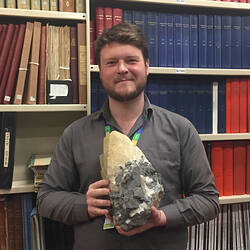Rocks and Ores
The Rocks and Ores Collection began in the 1850s with material collected by the Geological Survey of Victoria that was deposited with the Museum. The collection consists of several large components containing approximately 100,000 hand specimens.
The rock collection covers the full spectrum of Victorian rock types, largely obtained from field mapping by the Geological Survey of Victoria. It also contains rock suites from other important Australian localities and overseas regions such as the Italian Alps, Mediterranean volcanoes, and the Canadian Shield.
The ore collections contain material from historic Victorian and Australian mines and mineral deposits, such as the Central Victorian goldfields, Broken Hill in NSW, and King Island, Tasmania. It also contains suites from selected foreign locations including historic European metal mines and Fijian Gold-Tellurium deposits. There is also a large coal collection, reflecting early colonial interest in this resource.
Significance
The major significance of the rock and ore collections lies in their heritage value. They represent systematic acquisition during major periods of mining and geological investigation, in Victoria and elsewhere in Australia and overseas, as well as during periods of great debate over the origins of particular rock types. The various collections of mainly European rocks obtained from the Krantz dealership in Germany, or the Victorian mining specimens collected in the nineteenth century, could never be assembled again.
The Victorian ore collection is the most significant of its type, being representative of a host of small deposits yielding metals ranging from gold to tungsten and containing material that can no longer be collected. Of particular significance is the collection of 'indicators' from mines in the central Victorian goldfields.


